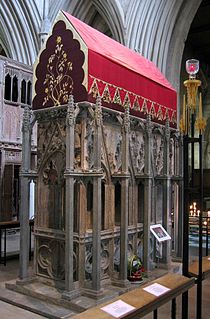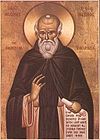
The liturgical year, also known as the church year or Christian year, as well as the kalendar, consists of the cycle of liturgical seasons in Christian churches that determines when feast days, including celebrations of saints, are to be observed, and which portions of Scripture are to be read either in an annual cycle or in a cycle of several years.
In the history of Christianity, the African Rite refers to a now defunct Christian, Western liturgical rite, and is considered a development or possibly a local use of the primitive Roman Rite. Centered around the Archdiocese of Carthage in the Early African church, it used the Latin language.
This article lists the feast days of the General Roman Calendar as they were at the end of 1954. It is essentially the same calendar established by Pope Pius X (1903–1914) following his liturgical reforms, but it also incorporates changes that were made by Pope Pius XI (1922–1939), such as the institution of the Feast of Christ the King, and the changes made by Pope Pius XII (1939–1958) prior to 1955, chief among them the imposition of the Feast of the Immaculate Heart of Mary upon the universal Church in 1944, the inscription of Pius X into the General Calendar following his 1954 canonization, and the institution of the Feast of the Queenship of Mary in October 1954.
The Church of England commemorates many of the same saints as those in the General Roman Calendar, mostly on the same days, but also commemorates various notable Christians who have not been canonised by Rome, with a particular though not exclusive emphasis on those of English origin. There are differences in the calendars of other churches of the Anglican Communion.

The Lutheran Calendar of Saints is a listing which specifies the primary annual festivals and events that are celebrated liturgically by some Lutheran Churches in the United States. The calendars of the Evangelical Lutheran Church in America (ELCA) and the Lutheran Church–Missouri Synod (LCMS) are from the 1978 Lutheran Book of Worship and the 1982 Lutheran Worship. Elements unique to the ELCA have been updated from the Lutheran Book of Worship to reflect changes resulting from the publication of Evangelical Lutheran Worship in 2006. The elements of the calendar unique to the LCMS have also been updated from Lutheran Worship and the Lutheran Book of Worship to reflect the 2006 publication of the Lutheran Service Book.
The General Roman Calendar is the liturgical calendar that indicates the dates of celebrations of saints and mysteries of the Lord in the Roman Rite, wherever this liturgical rite is in use. These celebrations are a fixed annual date; or occur on a particular day of the week ; or relate to the date of Easter. National and diocesan liturgical calendars, including that of the diocese of Rome itself as well as the calendars of religious institutes and even of continents, add other saints and mysteries or transfer the celebration of a particular saint or mystery from the date assigned in the General Calendar to another date.

The word saint derives from the Latin sanctus, meaning holy, and has long been used in Christianity to refer to a person who was recognized as having lived a holy life and as being an exemplar and model for other Christians. Beginning in the 10th century, the Church began to centralize and formalize the process of recognizing saints; the process whereby an individual was added to the canon (list) of recognized saints became known as canonisation.

Prior to the revision of the Anglican Church of Canada's (ACC) Book of Common Prayer (BCP) in 1962, the national church followed the liturgical calendar of the 1918 Canadian Book of Common Prayer. Throughout most of the twentieth century, the situation in Canada resembled that which pertained in much of the Anglican Communion: There was uncertainty as to whether post-Reformation figures could or should be commemorated. In the words of the calendar's introduction, "New names have been added from the ancient calendars, and also from the history of the Anglican Communion, without thereby enrolling or commending such persons as saints of the Church." The 1962 revision added twenty-six post-Reformation individuals, as well as commemorations of the first General Synod and of "The Founders, Benefactors, and Missionaries of the Church in Canada." Of the calendar days, twenty-eight were highlighted as "red-letter days" — that is, days of required observation.

The Anglican Church of Melanesia (ACoM), also known as the Church of the Province of Melanesia and the Church of Melanesia (COM), is a church of the Anglican Communion and includes nine dioceses in the Solomon Islands, Vanuatu and New Caledonia. The newly enthroned and installed primate and Archbishop of Melanesia is George Takeli. He succeeds the retired archbishop David Vunagi, who left office on 6 September 2015.

Mass in the Catholic Church goes by many names. As fundamentally an action of thanksgiving to God it is called Eucharist, which means thanksgiving. Other terms for it are Lord's Supper, Breaking of Bread, Eucharistic assembly, memorial of the Lord's Passion and Resurrection, holy sacrifice of the Mass, Holy and Divine Liturgy, Sacred Mysteries, Most Blessed Sacrament, Holy Communion, the holy things, and finally Holy Mass from the sending forth (missio) of the faithful.
The veneration of saints in the Episcopal Church is a continuation of an ancient tradition from the early Church which honors important and influential people of the Christian faith. The usage of the term "saint" is similar to Roman Catholic and Orthodox traditions. Episcopalians believe in the communion of saints in prayer and as such the Episcopal liturgical calendar accommodates feasts for saints.

The Gospel in Christian liturgy refers to a reading from the Gospels used during various religious services, including Mass or Divine Liturgy (Eucharist). In many Christian churches, all present stand when a passage from one of the Gospels is read publicly, and sit when a passage from a different part of the Bible is read. The reading of the Gospels, often contained in a liturgical edition containing only the four Gospels, is traditionally done by a minister, priest or deacon, and in many traditions the Gospel Book is brought into the midst of the congregation to be read.
In the Calendar of the Scottish Episcopal Church, each holy and saint’s day listed has been assigned a number which indicates its category. It is intended that feasts in categories 1 - 4 should be kept by the whole church. Days in categories 5 and 6 may be kept according to diocesan or local discretion. Commemorations not included in this Calendar may be observed with the approval of the bishop.
This is a calendar of saints list for the Armenian Apostolic Church.
The calendar of the Anglican Church of Australia follows Anglican tradition with the addition of significant people and events in the church in Australia.
The calendar of the Anglican Church of Southern Africa is published in An Anglican Prayer Book 1989.
This article lists the feast days of the General Roman Calendar as approved on 25 July 1960 by Pope John XXIII's motu proprioRubricarum instructum and promulgated by the Sacred Congregation of Rites the following day, 26 July 1960, by the decree Novum rubricarum. This 1960 calendar was incorporated into the 1962 edition of the Roman Missal, continued use of which Pope Benedict XVI authorized in the circumstances indicated in his 7 July 2007 motu proprio Summorum Pontificum.

The Matins Gospel is the solemn chanting of a lection from one of the Four Gospels during Matins in the Orthodox Church and those Eastern Catholic churches which follow the Byzantine Rite.
In the Roman Rite of the Catholic Church, days throughout the liturgical year are given varying ranks. These ranks determine which Mass takes precedence when two liturgical days coincide on the same day, as well as when a feast falls on a Sunday or certain other, higher-ranking days. In addition, higher-ranking liturgical days are also privileged by certain liturgical elements: for instance, the Mass of a solemnity will include recitation or singing of the Gloria in Excelsis and the Credo, while that of a feast will have the Gloria but not the Credo, whereas a memorial will have neither.
The calendar of saints of the Episcopal Anglican Church of Brazil follows the tradition of The Episcopal Church (TEC), from whom it was a missionary district until 1965. TEC's calendar of saints, in turn, has its origins in the calendar of the Church of England and in the General Roman Calendar. As such, IEAB commemorates many of the figures present in the Roman Calendar, most of them on the same dates, but it also commemorates various notable Post-Reformation uncanonized Christians, especially those of Brazilian origin.








